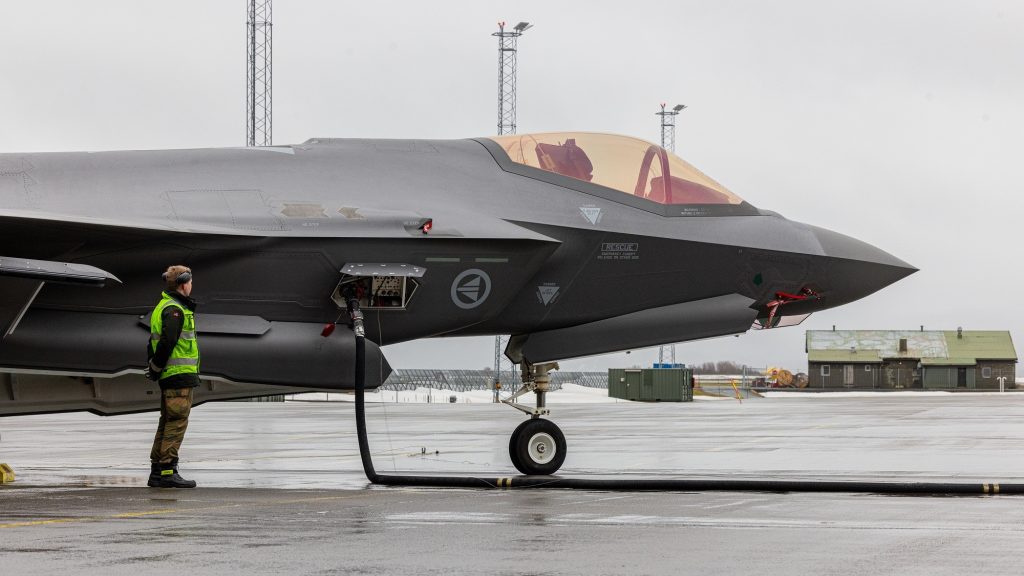The milestone “signal(s) progress toward reducing emissions while maintaining mission readiness,” according to Lockheed Martin.
On Jan. 14, 2025, the Royal Norwegian Air Force conducted a test flight of an F-35A Lightning II fighter using a blend of traditional jet fuel and Synthetic Aviation Turbine Fuel (SATF), or Sustainable Aviation Fuel (SAF), as Lockheed Martin announced the aircraft’s certification on the fuels.
The test, conducted at Ørland Main Air Station in Norway, reportedly used a 60/40 (traditional / SATF) blend of fuels, though Lockheed Martin has certified up to a 50/50 blend. Norway is currently exploring a few different ways to reduce their military’s carbon footprint. “Our fighter jets currently account for about one-third of direct CO2 emissions within the defense sector,” said Norwegian Defense Minister Bjørn Arild Gram. “Using sustainable fuel can reduce emissions and strengthen supply security. The aim is to contribute to achieving climate targets while enhancing preparedness.”
‘Every sector must reach net zero (carbon emissions), including the armed forces. This test program highlights the importance of technological innovation. In the long term, we aim to increase the use of sustainable fuels in aviation. The armed forces are now part of this development,’ said Minister of Climate and Environment Andreas Bjelland Eriksen.
According to Lockheed Martin, these Synthetic Aviation Turbine Fuels are made from both renewable sources such as waste oils, agricultural byproducts, and “other sustainable feedstocks” as well as nonrenewable sources such as coal and natural gas. Norway’s test, specifically, used a fuel made from “waste, residues and by-products”. Lockheed Martin also points out that diversifying fuel types available to the F-35 “reduces dependence on traditional supply chains”, which effectively gives the type more freedom to operate in even more environments. “SATFs provide a versatile and reliable alternative to conventional jet fuel, ensuring operational consistency without compromising performance,” says Lockheed Martin in their press release.
Chauncey McIntosh, the vice president and general manager of the F-35 program, spoke on the test and certification, saying, “Lockheed Martin is committed to ensuring the F-35 is always ready for any customer mission. Adding new fuel sources helps make this happen by diversifying the supply chain while maintaining operational excellence. As the cornerstone of the joint fleet, the F-35 will continue to lead the U.S. and allied air dominance mission for decades to come.”
Ørland Main Air Station itself is something of a test base for Norway’s green initiatives, including testing mobile hybrid systems with wind turbines and solar panels. The base is also ingrained into the local community, heavily involved with local businesses, municipalities, and counties.
Norway also acknowledges their country’s challenges in sustainable fuel availability and production in their press release.
The ability to use alternate fuels also has large implications for the United States, who is the largest operator of the F-35, as it looks for new ways to fight a near-peer in the Pacific region with limited resources. With the sustainable fuels getting the greenlight on the Lightning II, the type joins others in the U.S. military arsenal including the C-17A Globemaster III, F/A-18E/F Super Hornet (and EA-18G), the P-8A Poseidon, and others.
The RNoAF joins other European air forces who are moving to introducing SAF in the last few years. One example is the Royal Air Force, which has already tested SAF on the Voyager tanker, the Typhoon fighter jet and the Hercules cargo aircraft. The Voyager has already flown with 100% SAF and the goal is to do the same with the other aircraft, which so far flew with a 50% blend of fuels.
The F-35A Lightning II in the Region
Now numbering around 40 aircraft, Norway’s F-35A fleet is already well-established in their role in deterring Russia in Europe. Very recently the Norwegian F-35s stationed in Poland were scrambled to intercept “a massive number” of Russian aircraft headed toward Polish airspace. The Royal Norwegian Air Force currently plans to operate 52 of the type.
Norway has used their Lightning II’s for their Quick Reaction Alert (QRA) mission since 2022 after phasing out their F-16AM/BM fighters. Uniquely, the Norwegian F-35s are the same as other A-models with the exception of being equipped with a drag chute. The Scandinavian nation declared initial operational capability (IOC) with the F-35 in 2019.
The fighter is becoming more and more common in the region with many NATO members, including Norway, the United States, Denmark, and the United Kingdom, soon being joined by Germany, Poland, Finland, the Czech Republic, and others. The North Atlantic Treaty Organization (and friends) have done their best to keep the West’s newest fighter right on Russia’s doorstep.

